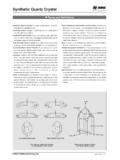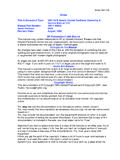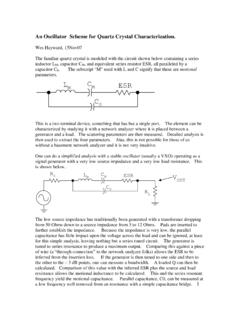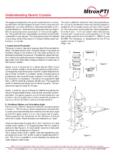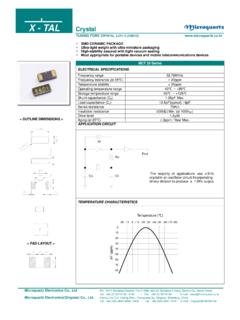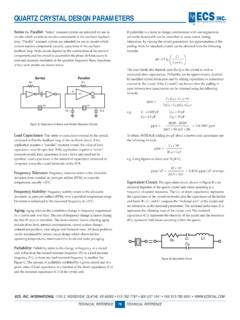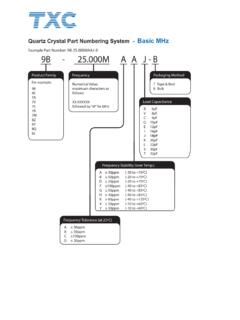Transcription of Crystalline Silica - Quartz and Cristobalite
1 Crystalline Silica Quartz and Cristobalite Method number: ID-142. Version: 3. Target concentration: 50 g/m (for Quartz and Cristobalite ). 3. OSHA PEL: 50 g/m (combined polymorphs). 3. 25 g/m action level 3. ACGIH TLV: mg/m (respirable fraction). ( - Quartz and Cristobalite ). Procedure: Samples are collected by drawing workplace air through pre-weighed 5- m pore size, 37-mm diameter low ash polyvinyl chloride (PVC) filters preceded by 10-mm nylon Dorr Oliver cyclones. The weight of the respirable dust is determined by gravimetric analysis. The PVC filters are dissolved and the samples are suspended in tetrahydrofuran (THF). The samples are then deposited on silver membranes and analyzed by X-ray diffraction (XRD). Recommended sampling time and sampling rate: 480 min at L/min (816 L). 3. Reliable quantitation limit: g/sample ( g/m ) Quartz 3. g/sample ( g/m ) Cristobalite Standard error of estimate at the target concentration: Quartz Cristobalite Status of method: Fully validated method.
2 1981. Revised December 1996. Revised October 2015. Revised May 2016 Fern Stones Eddie Robinson Daniel N. Johansen Brian J. Albrecht Methods Development Team Industrial Hygiene Chemistry Division OSHA Salt Lake Technical Center Sandy UT 84070-6406. 1 of 39. 1. General Discussion For assistance with accessibility problems in using figures and illustrations presented in this method, please contact the Salt Lake Technical Center (SLTC) at (801) 233-4900. These procedures were designed and tested for internal use by OSHA personnel. Mention of any company name or commercial product does not constitute endorsement by OSHA. Background History Several analytical techniques have been used to determine Crystalline Silica exposure in the workplace. These techniques include atomic absorption, colorimetry, gravimetry, microscopy, infrared spectroscopy (IRS), and X-ray diffraction (XRD).
3 OSHA Method ID-142 uses XRD which is the only technique capable of distinguishing polymorphs and quantifying Crystalline Silica in a wide variety of industrial dusts. This method is similar 1. to NIOSH Method 7500. The previous version of OSHA Method ID-142 (version ) validated analytical 2. procedures using current OSHA method development guidelines to determine accuracy, precision and overall method performance at a target concentration of 50. 3. g/m for both Quartz and Cristobalite . This target concentration was chosen to match 3. the PEL proposed by OSHA in 2013. The 2013 proposal included an action limit of 25. 3. g/m . Version of this method incorporated the use of an auto-diluter for standard preparation, and described the addition of carbon black to samples and standards to center the depositions in the X-ray beam. This version (version ) includes an 4.
4 Updated calculations section to reflect the PEL that was adopted in 2016. Toxic effects (This Section is for information only and should not be taken as the basis of OSHA policy.). Two polymorphs of Crystalline Silica , Quartz and Cristobalite , have been classified as 5,6. Group 1 carcinogens carcinogenic to humans by the International Agency for Research on Cancer (IARC). Health hazards associated with exposure to Crystalline Silica arise from the inhalation of respirable particles. Respirable Crystalline Silica 7. consists of particles that are smaller than 10 m in aerodynamic diameter. In addition to causing the disabling and irreversible lung disease silicosis, respirable Crystalline 8 9. Silica exposure also increases the risk of lung cancer, renal disease, and other 1. Key-Schwartz, R.; Ramsey, D.; Schlecht, P. Silica , Crystalline , by XRD (Filter Redeposition) (NIOSH Method 7500), 2003.
5 Center for Disease Control, The National Institute for Occupational Safety and Health (NIOSH) Web site. (accessed September 2015). 2 Eide, M.; Simmons, M.; Hendricks, W. Validation Guidelines for Air Sampling Methods Utilizing Chromatographic Analysis, 2010. United States Department of Labor, Occupational Safety & Health Administration Web site. (accessed September 2015). 3. Occupational Exposure to Respirable Crystalline Silica , Proposed Rule. Office of the Federal Register [US] Web site. (accessed April 2015). 4. Occupational Exposure to Respirable Crystalline Silica ; Final Rule. Office of the Federal Register [US] Web site. (accessed May 2016). 5. IARC Working Group on the Evaluation of Carcinogenic Risks to Humans. IARC Monographs: Silica , Some Silicates, Coal Dust and Para-Aramid Fibrils [Online]; International Agency for Research on Cancer: Lyon, FR, 2009; Vol.
6 68, pp 41-242. (accessed September 2015). 6. IARC Working Group on the Evaluation of Carcinogenic Risks to Humans. IARC Monographs: Arsenic, Metals, Fibres, and Dusts, A Review of Human Carcinogens [Online]; International Agency for Research on Cancer: Lyon, FR, 2009; Vol. 100 C, pp 355- 406. (accessed September 2015). 7. Ziskind, M.; Jones, R. N.; Weill, H. Silicosis. Am. Rev. Respir. Dis. 1976, 113, 643-665. 8. Liu, Y.; Steenland, K.; Rong, Y.; Hnizdo, E.; Huang, X.; Zhang, H.; Shi, T.; Sun, Y.; Wu, T.; Chen, W. Exposure-Response Analysis and Risk Assessment for Lung Cancer in Relationship to Silica Exposure: A 44-Year Cohort Study of 34,018 Workers. Am. J. Epidemiol. 2013, 178, 1424-1433. 2 of 39. occupational diseases including non-malignant respiratory diseases; such as chronic 10. obstructive pulmonary disease (COPD). These occupational diseases, either alone or in concert, are life-altering and debilitating disorders.
7 Silicosis most commonly occurs as a diffuse nodular pulmonary fibrosis with scarring 11. around trapped Silica particles. Three types of silicosis have been described: an acute form following intense exposure to respirable dust of high Crystalline Silica content for a relatively short period ( , a few months or years); an accelerated form resulting from about 5 to 15 years of heavy exposure to respirable dusts of high Crystalline Silica content; and, most commonly, a chronic form that typically follows less intense 12,13. exposure of usually more than 20 years. Cristobalite was previously considered more toxic than Quartz , but recent studies have 14. shown them to have comparable pathogenic effects. 15. Workplace exposure Silica minerals (SiO2) occur in either Crystalline or non- Crystalline (amorphous) forms and are a component of soil, sand, and rocks. Silica minerals are sometimes called "free Silica ," to distinguish them from other silicates, complex mineral structures containing bound silicon dioxide.
8 Crystalline Silica is a collective term that can refer to Quartz , Cristobalite , tridymite, and several other rare Silica minerals. The term Crystalline Silica usually refers only to the polymorphs Quartz , Cristobalite and tridymite. All of the Crystalline Silica minerals have the same chemical composition, but have different crystal structures and are thus termed polymorphs. Quartz is the most common polymorph of Crystalline Silica and is the single most 16. abundant mineral in the earth's crust. During some natural and industrial processes Cristobalite and tridymite are formed at high temperature from Quartz , diatomaceous earth, and amorphous Silica . Diatomaceous earth that has been flux-calcined (heated, usually in the presence of sodium carbonate) can contain a significant amount of 17. Cristobalite . Crystalline Silica is an important industrial material, and occupational exposure can occur in a variety of workplace settings including mining, manufacturing, construction, maritime, and agriculture.
9 Industrial processes that have been associated with high rates of silicosis include sandblasting, sand-casting foundry operations, mining, tunneling, cement cutting and demolition, masonry work, granite cutting, and hydraulic 9. Steenland, K.; Attfield, M.; Mannejte, A. Pooled Analyses of Renal Disease Mortality and Crystalline Silica Exposure in Three Cohorts. Ann. Occup. Hyg. 2002, 46, 4-9. 10. Park, R.; Rice, F.; Stayner, L.; Smith, R.; Gilbert, S.; Checkoway, H. Exposure to Crystalline Silica , Silicosis, and Lung Disease Other Than Cancer in Diatomaceous Earth Industry Workers: A Quantitative Risk Assessment. Occup. Environ. Med. 2002, 59, 36-43. 11. Preventing Silicosis and Deaths in Construction Workers, DHHS (NIOSH) Publication No. 96-112, 1996. Center for Disease Control, The National Institute for Occupational Safety and Health (NIOSH) Web site. (accessed September 2015).
10 12. Becklake, M. R. Pneumoconiosis. In: Textbook of Respiratory Medicine, Second Ed.; Murray, J. F., Nadel, J. A., Eds.; W. B. Saunders Co.: Philadelphia, PA, 1994; pp 1955-2001. 13. Balaan, M. R.; Banks, D. E. Silicosis. In: Environmental and Occupational Medicine, Second Ed.; Rom, W. N., Ed.; Lippincott Williams & Wilkins: Philadelphia, PA,1992; pp 345-358. 14. Bolsaitis, P. P.; Wallace, W. E. The Structure of Silica Surfaces in Relation to Cytotoxicity, In: Silica and Silica -Induced Lung Diseases. Castranova, V., Vallyathan, V., Wallace, W. E., Eds.; CRC Press, Inc.: Boca Raton, FL, 1996; pp 79-89. 15. National Emphasis Program Crystalline Silica , 2008. United States Department of Labor, Occupational Safety & Health Administration Web site. (accessed September 2015). 16. Klein, C. Rocks, MineraIs, and a Dusty World. Rev. Mineral. 1993, 28 (Health Effects of Mineral Dusts), 8-59.










